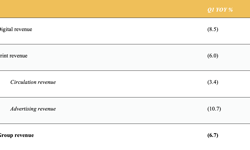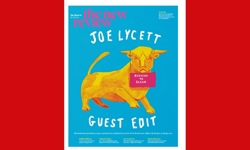| State of online development | |
| Over the course of four issues, Andrea Kirkby will review the state of online development as follows: | |
| Sep/Oct 2005 | National newspapers |
| Nov/Dec 2005 | Consumer magazines |
| Jan/Feb 2006 | Regional newspapers |
| Mar/Apr 2006 | B2B Magazines |
It's now ten years since one of the epoch-making events of the internet - the flotation of Netscape in August 1995. With its web browser interface, Netscape took the web away from the nerds and delivered a new medium to the world - one that threatened to change the media for ever. Ten years later, how are the national newspapers doing on - and off - line?
The answer seems to be pretty well. There is still quite a wide spectrum of models, from the Express's vestigial website to the Guardian's expansive internet presence. But all the national newspapers have survived the growth of the internet, and almost all have created their own compelling online content.
Senior management - with few exceptions - is now convinced of the need for an online presence. Rupert Murdoch spoke recently of the need to "free our minds" for the digital revolution, describing the traditional media as "complacent". As Richard Foan of ABC Electronic says, "more people at a senior level are recognising the significance of the internet."
Growing maturity
But the market has settled down since the mad days of the dotcom boom. No one is spending vast amounts on internet strategies any more (though News International's recent purchase of MySpace might be an interesting exception). The fact that the majority of newspaper sites are now being audited, and on a more regular basis rather than as one-offs, is another sign that the market is becoming more mature.
No one really knows whether the web is stealing circulation, or on the other hand whether it is building readership. Richard Foan says "it's difficult to tell; if circulation is down x percent year on year, is it being replaced by web use up x percent year on year? There's no precise formula for whether one form of readership replaces another."
Still, we now know that web readers can be monetised, whether by paid for content or by ads. As Richard Foan says, "It's guaranteed that some people are making money on web presence - the internet is no longer a cash sink." While it may not be making a very high return, Simon Waldman, director of digital publishing for Guardian Newspapers, says that Guardian Online is now washing its face.
The wider world
Newspapers have also carved out a respectable place for themselves in the online world. However, as Richard Foan says, "the competitive situation is considerably more complex" than in print - where not much has changed since the Indie's launch in 1986. He points to the BBC's website as a major competitor with a web, but no print presence.
Simon Waldman believes that understanding the internet market - not just the print market - is absolutely crucial. The Guardian, though the largest broadsheet site by some way, is dwarfed by the major portals (eg Yahoo, MSN), which take the lion's share of advertising money online. He sees Guardian Online as "the top of tier 2", with a more defined audience than the one-size-fits-all portals. As Richard Foan notes, despite the arrival of online competitors, "the power of the brand is still absolutely there."
While ten years ago many believed that the website merely replicated the newspaper, a more sophisticated relationship between the two has now developed. While digital editions are being created, they are quite a different thing from newspaper websites, says Mike Newman, circulation director at the Daily Mail. He sees digital editions as a paid-for niche market - an alternative to the print product for the geographically remote reader. (And they'll stay niche, he thinks, until they can be included in the ABC for the main title; but that's another story.)
As far as the website is concerned, "you don't get the Daily Mail online." The website is a complementary product, with some things - such as message boards, which Newman describes as "a real-time letters page" - the newspaper doesn't have, but also minus some of the print content.
Associated Newspapers has also developed specialist websites which use the same content base as the print titles, but which have different branding - for instance Thisismoney. Northern & Shell's launch of a new website conflating content from the Express and Daily Star together with OK! and Happy magazines, seems to copy this strategy of creating new brands. This seems to be a minority approach to the internet, though, with most papers - including the Sun as well as the quality papers - promoting their print brands strongly online.
Paid-for vs free
Paid-for content has gained increasing acceptance as part of a mixed model. However, decisions on what goes into the paid-for box vary. On the Independent site, Richard Withey corralled his best columnists, notably Robert Fisk, into a paid-for product, but kept most of the news and reviews free. He says "we haven't put any more [content] into it. We think we got it right first time in terms of what we kept free and what went behind the barrier."
On the Guardian site, the content is free, but paid-for services include SMS alerts and PDA content as well as the ability to subscribe to an ad-free site. So here, rather than valuing the content itself, it's the method of delivery that is charged for (with the exception of the crossword, also paid-for). The Telegraph also has paid-for mobile services, while the Times charges for its archive - another way of making the cut.
The tabloids also offer reams of paid-for content, generally on the entertainment side - the Sun for instance has done well with Page3.com, as well as fantasy football. But the Daily Mail, like the Indie, charges for its columnists. And, of course, the crossword.
The Association of Online Publishers' latest survey showed that 63% of its members now charge for content, against 58% in 2004; content accounts for 19% of members' revenue - still small in relation to advertising, particularly for national papers (AOP's membership includes B2B magazines, which typically have a higher paid-for quota). Alexandra White of the AOP puts members' annual revenue from paid content at "around the £40m mark, though this can't be taken as covering the entire UK market."
While the completely free site has probably disappeared, the completely subscription site is also coming under fire. Richard Withey makes no secret of his view that you need free content to attract users, otherwise you can't monetise the premium content. The Wall Street Journal, bastion of the all-subscription site, may now be changing its views, says Alan Meckler of research house Jupiter Media, since its parent, Dow Jones, has now bought the mainly open-access MarketWatch.
Leading the paid-for stakes in the UK is, unsurprisingly, the Financial Times, with 80,000 subscribers paying £75 a year (£200 including value-added services such as company financials and a world press archive). But even at the FT, Nigel Pocklington, online publishing director, believes in the mixed model - there needs to be a balance between the value of "a newspaper of record" and the free material "to feed the blogosphere and search engines so that we can attract new readers", he admitted at the In The City Interactive event in June this year.
One interesting shift is a relative increase in subscriptions, which now generate more than twice as much revenue as micropayments. However Alexandra White says that "heralding the death of micropayments is a bit premature. Only last week the Guardian announced it was adding a micropayment model to its digital edition. The key thing seems to be to offer the user a choice of payment options."
Leaders and laggards
Who are the leaders and laggards in the sector? It's difficult not to choose Guardian Online as the leader in the use of the web's capabilities, including blogging, audio, video and RSS, but most of the broadsheets are putting up a good fight and have rich, sticky sites with 30-40m page impressions and 4m or so users according to ABC Electronic (only the Indie isn't audited).
Among the tabloids, the Express has a severely limited web resource (the new Daily Snack will apparently employ a single journalist). On the other hand Associated Newspapers has done well; but still Mike Newman says of the Mail that "our view is we think the internet is a thing whose time will come and we're not sure when, but we're making sure we will be there when it does" - a relatively defensive attitude compared to the evangelising attitude of some of the broadsheets, and the newly converted Murdoch.
The big winner amongst the tabloids is the Sun, according to the ABC figures - at 125.9m page impressions beating the Guardian, biggest of the broadsheet sites, into second place. The Sun also seems to be making all the running on content - using the technology to the full, with mobile services and video newsfeeds. Internet innovation seems to be a highly effective strategy for expanding the digital readership.
Meanwhile the Mirror seems to have been slightly handicapped by the fact that its parent company's online strategy is focused on the regional papers - for instance with its £16.6m purchase of smartnewhomes.com, which aims to defend the regionals' classified advertising base.
New technologies
So far, you might think the national papers had settled down online and could put their feet up. But in fact, there is some quite disruptive technology out there, and that could shake the whole sector up again.
First, broadband, which started slowly in the UK but has taken off in the last year, overtaking dialup access. Alexandra White says "broadband is creating lots of opportunities for creating new content and including more audiovisual content online," and mentions the Sun's new breaking news videos as a good example. So far, newspapers have latched on to audio and video as opportunities to create a better media product for users, rather than as profit making opportunities.
Secondly, mobile has become a huge opportunity. SMS alerts and other such services have become a moneymaker for most papers, and some of the tabloids are doing well with ringtones and other downloadable content. However, until now, other mobile content hasn't been particularly profitable.
Richard Withey is looking forward to 3G, but in particular to O2's launch of imode. So far, he says, "mobile has not recognised the need to pay the content provider for being in a mobile environment, and there's not an advertising model worth a damn." But imode has historically paid better and should change that - enabling mobile content to take off.
Alexandra White, too, believes that "the main barrier is the high cut taken by the mobile operators." She rates the FT's mobile services, which cover most of the technologies available, from SMS through to WAP and Blackberry. The Sun has also been imaginative in using mobile; 'Sun mobile' launched in June this year, with ringtones and wallpapers to download.
Mobile is easy to enter, since a number of players specialise in mobile content; for instance Bango (working with the Sun) and Roundpoint, which manages PDA crosswords for most of the nationals. That's a contrast with the early days, when most newspapers had to invent their own technology and run their own websites. Auditing is coming to mobile soon, too. "We will audit mobile content separately from the web product," says Richard Foan. "How can you compare a text message with a website?"
RSS
But the biggest change in sight is RSS (Rich Site Summary/Really Simple Syndication). Most of the broadsheet sites now display a discreet RSS button and according to the FT, volumes are doubling monthly. The fact that Microsoft is including RSS support in the next version of its operating system is sure to encourage its use.
Richard Withey believes that RSS, together with search engines such as Google, is changing the way newspapers compete. Though he has some concerns that Google is "building its business on the back of our content", he believes that both are now an inevitable part of the marketing mix.
But RSS changes the way the game works. Simon Waldman says that with RSS, "while you still control the feeds, what you do lose control of is the look and feel and structure of people's first contact with your content. You become part of an aggregated whole, and that has some good sides and some not so good sides. At the moment we don't know about the long term impact that will have on our audiences. We do know that RSS offers consumers very strong value - so it is going to take off."
Richard Withey is also ambivalent about RSS. He says that "two words have come back to haunt us from the early days of the web - disintermediation and personalisation." The 'Daily Me', on which Yahoo and Knight Ridder spent vast amounts uselessly, is now possible - delivered by RSS. "It didn't work then, it does work now." But - an important point - it is no longer under the control of the media owner; it is controlled by the user.
The media world is breaking down. Simon Waldman says that "instead of a collection of rigid entities, that is, websites, you have a more fluid and fragmented world of content. For traditional publishers who put an emphasis on the structure and organisation of content, that's quite challenging." And he warns that this plays into the hands of the portals - so that part of his job is now helping strengthen the Guardian's relationship with Yahoo, which he sees as "similar to our relationships with retailers".
There are limits to what RSS can do at the moment. According to Forrester Research, only 2% of the online population is using it, and there's no way to commercialise it properly yet. But it will grow, that much is for certain.
Journalism changing
Even the nature of journalism is changing, as blogging takes off. The Guardian started a web log four years ago, and is now on the third or fourth iteration. But Simon Waldman admits it's a tricky act to get right; "you need to get the right balance between the informality you expect from a blog and the quality you expect from a national newspaper." That may be why most other papers still aren't doing it.
Coverage of the London bombings showed how the media has changed. Richard Withey points out the huge amount of "user content, which the media owners grabbed and used" - photos and messages from those actually involved in the events. And Simon Waldman praises the fluidity of the blog as a way of responding to confusing events - "you can operate outside the traditional story structure - it's so much more fluid and flexible".
We will undoubtedly see a further change in the relationship between readers and news media over the next few years. That, rather than broadband or 3G phones, will be the biggest change facing the national newspapers. And that is why papers who don't 'get' the web will fall behind. As Richard Withey says, the role of the media is changing. "In the new world, the media become editors and moderators. The time when journalists could preach to people is dying."










